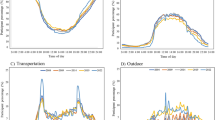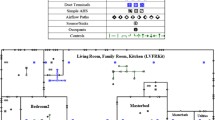Abstract
The current exposure-effect curves describing sandstorm PM10 exposure and the health effects are drawn roughly by the outdoor concentration (OC), which ignored the exposure levels of people’s practical activity sites. The main objective of this work is to develop a novel approach to quantify human PM10 exposure by their socio-categorized micro-environment activities-time weighed (SCMEATW) in strong sandstorm period, which can be used to assess the exposure profiles in the large-scale region. Types of people’s SCMEATW were obtained by questionnaire investigation. Different types of representatives were trackly recorded during the big sandstorm. The average exposure levels were estimated by SCMEATW. Furthermore, the geographic information system (GIS) technique was taken not only to simulate the outdoor concentration spatially but also to create human exposure outlines in a visualized map simultaneously, which could help to understand the risk to different types of people. Additionally, exposure-response curves describing the acute outpatient rate odds by sandstorm were formed by SCMEATW, and the differences between SCMEATW and OC were compared. Results indicated that acute outpatient rate odds had relationships with PM10 exposure from SCMEATW, with a level less than that of OC. Some types of people, such as herdsmen and those people walking outdoors during a strong sandstorm, have more risk than office men. Our findings provide more understanding of human practical activities on their exposure levels; they especially provide a tool to understand sandstorm PM10 exposure in large scale spatially, which might help to perform the different categories population’s risk assessment regionally.





Similar content being viewed by others
Abbreviations
- GIS:
-
geographic information system
- MEATW:
-
micro-environment and activities-time weighed
- OC:
-
outdoor concentration
- PM10 :
-
particle matter 10
- SCMEATW:
-
socio-categorized micro-environment activities-time weighed
References
Bell ML, Levy JK, Lin Z (2008) The effect of sandstorms and air pollution on cause-specific hospital admissions in Taipei, Taiwan. Occup Environ Med 65:104–111
C. CR, N. C, G. EM, N.-A. A, V. SP, B. D (2017) Environ Res 156:74
Canagaratna MR, Jayne JT, Ghertner DA, Herndon S, Shi Q, Jimenez JL, Silva PJ, Williams P, Lanni T, Drewnick F (2004) Chase studies of particulate emissions from in-use New York City vehicles. Aerosol Sci Technol 38:555–573
Chen B, Kan H (2008) Air pollution and population health: a global challenge. Environ Health Prev Med 13:94–101
Chen F, Fan Z, Qiao Z, Cui Y, Zhang M, Zhao X, Li X (n.d.) Environ Pollut
Delfino RJ, Quintana PJ, Floro J, Gastañaga VM, Samimi BS, Kleinman MT, Liu LJ, Bufalino C, Wu CF, Mclaren CE (2004) Association of FEV1 in asthmatic children with personal and microenvironmental exposure to airborne particulate matter. Environ Health Perspect 112:932–941
Dominici F, Daniels M, Zeger SL, Samet JM (2002) J Am Stat Assoc 330:1237–1238
Dons E, Panis LI, Poppel MV, Theunis J, Wets G (2012) Personal exposure to black carbon in transport microenvironments. Atmos Environ 55:392–398
Downs SH, Schindler C, Liu LJS, Keidel D, Bayeroglesby L, Brutsche MH, Gerbase MW, Keller R, Künzli N, Leuenberger P (2007) Reduced exposure to PM10 and attenuated age-related decline in lung function. N Engl J Med 357:2338–2347
Estarlich, Iñiguez, Llop, Esplugues, Ballester (2008) Epidemiology 19
P. Gupta, S. Singh, S. Kumar, M. Choudhary and V. Singh, J Asthma Off J Assoc Care Asthma 2012, 49, \, Effect of dust aerosol in patients with asthma, 138
Hänninen O, Jantunen M, Nawrot TS, Nemery B (2007) Response to findings on association between temperature and dose response coefficient of inhalable particles (PM10). J Epidemiol Community Health 61:838 author reply 838-839
Hänninen O, Zaulisajani S, Maria RD, Lauriola P, Jantunen M (2009) Environ Model Assess 14:419–429
Hou Q, An X, Yan T, Sun Z (2016) Assessment of resident’s exposure level and health economic costs of PM10 in Beijing from 2008 to 2012. Sci Total Environ 563-564:557–565
Jensen SS (1999)
Jian Z (2007) In, Influence of dust weather on the number of outpatient clinic on respiratory and cardiovascular Vol. Shanxi University
Kim H, Lee JT, Hong YC, Yi SM, Kim Y (2004) Evaluating the effect of daily PM10 variation on mortality. Inhal Toxicol 16(Suppl 1):55–58
Larrieu, Lefranc, Medina, Jusot JF, Chardon, Riviere, Prouvost, Le T (2006) Epidemiology 17
Liu XC, Zhong YT, He Q, Yang XH, Mamtimin A, Wen H (2012) Sci Cold Arid Regions 04:259
Long L, Wang X, Feng B, Zhang Y, Yang H (2010) Environ Sci Technol 33:140–145
Macnee W, Donaldson K (2003) Mechanism of lung injury caused by PM10 and ultrafine particles with special reference to COPD. Eur Respir J Suppl 40:47s–51s
Masih A, Lall AS, Taneja A, Singhvi R (2017) Exposure profiles, seasonal variation and health risk assessment of BTEX in indoor air of homes at different microenvironments of a terai province of northern India. Chemosphere 176:8–17
Munkhdorj B, Bao Y, Ei MY, Battsengel LB (2014)
Piedrahita R, Kanyomse E, Coffey E, Xie M, Hagar Y, Alirigia R, Agyei F, Wiedinmyer C, Dickinson KL, Oduro A (2017) Exposures to and origins of carbonaceous PM 2.5 in a cookstove intervention in Northern Ghana. Sci Total Environ 576:178–192
Sajani SZ, Hänninen O, Marchesi S, Lauriola P (2011) Erratum: comparison of different exposure settings in a case–crossover study on air pollution and daily mortality: counterintuitive results. J Expo Sci Environ Epidemiol 21:222
Shao Y, Dong CH (2006) A review on East Asian dust storm climate, modelling and monitoring. Glob Planet Chang 52:1–22
S. Sharma, Sustain Environ Res 2013, 23, 393–402
Stroh E (2011) Metal Mine 2011:2
Tang R, Blangiardo M, Gulliver J (2013) Using building heights and street configuration to enhance intraurban PM10, NO(X), and NO2 land use regression models. Environ Sci Technol 47:11643–11650
Vinceti M, Rothman KJ, Crespi CM, Sterni A, Cherubini A, Guerra L, Maffeis G, Ferretti E, Fabbi S, Teggi S (2012) Leukemia risk in children exposed to benzene and PM10 from vehicular traffic: a case–control study in an Italian population. Eur J Epidemiol 27:781–790
Wilson WE, Mar TF, Koenig JQ (2007) Influence of exposure error and effect modification by socioeconomic status on the association of acute cardiovascular mortality with particulate matter in Phoenix. J Expo Sci Environ Epidemiol 17(Suppl 2):S11–S19
Wong CM, Tsang H, Lai HK, Thomas GN, Lam KB, Chan KP, Zheng Q, Ayres JG, Lee SY, Lam TH (2016) Cancer mortality risks from long-term exposure to ambient fine particle. Cancer Epidemiol Biomark Prev 25:839–845
Yue P, Niu SJ, Shen JG, Ge ZP (2009) J Nat Dis 18:118–123
Zanobetti A, Schwartz J (2013) Environ Health Perspect 113:978–982
Zeka A, Zanobetti A, Schwartz J (2005) Short term effects of particulate matter ce cause specific mortality: effects of legs and modification by city characteristics. Occup Environ Med 62:718–725
Zhang F, Xu J, Zhang Z, Meng H, Wang L, Lu J, Wang W, Krafft T (2015) Environ Monit Assess 187:4711
Y. Zhenhua, Z. Yuexia, Z. Xiquan, Z. Jian, L. Bin and M. Ziqiang, Chin J Environ Sci 2015, 35, 277–284
Ziqiang M, Lei Z (2007) J Ecotoxicol 2:390–395
Ziqiang M, Jian z, Hong g, Bin L, Quanxi Z (2007) China Environ Sci 27:116–120
Acknowledgements
The authors are extremely grateful to staff at the Department of Environment and Health for their health statistics technical assistance. The findings and conclusions in this report are those of the authors.
Funding
The research presented here was supported by MEP-PRC Project named HBGY 201509040.
Author information
Authors and Affiliations
Contributions
Hongmei Wang carried out the questionnaire studies and PM exposure assessment, and participated in the drafting of the manuscript. Shihai Lv conceived of the study and contributed ideas in geographical exposure. Zhaoyan Diao participated in the GIS analysis. Baolu Wang carried out the spatial analysis. Caihong Yu helped in the drafting of the manuscript. All the authors read and approved the final manuscript.
Corresponding author
Ethics declarations
Ethics approval and consent to participate
This study has been approved by Erlianhaote CDC agency, with the number 201601. All volunteers were administered on the condition that informed consents were signed.
Availability of data and supporting materials section
All detail materials were provided in supplement materials. If there is a query, please contact the author for data requests.
Consent for publication
Not applicable.
Competing interests
The authors declare that they have no competing interests.
Additional information
Responsible editor: Philippe Garrigues
Rights and permissions
About this article
Cite this article
Wang, H., Lv, S., Diao, Z. et al. Study on sandstorm PM10 exposure assessment in the large-scale region: a case study in Inner Mongolia. Environ Sci Pollut Res 25, 17144–17155 (2018). https://doi.org/10.1007/s11356-018-1841-5
Received:
Accepted:
Published:
Issue Date:
DOI: https://doi.org/10.1007/s11356-018-1841-5




